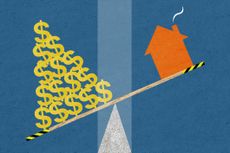Better Alternatives to President Obama's MyRA Plan
The new retirement savings plan is a Roth IRA in disguise, but it doesn’t provide as many investment choices.

Can you provide more information about the MyRA retirement-savings plan that the President talked about in his State of the Union speech? Should I invest in one?
The MyRA plan is designed to be an easy way for people who have never saved to get started. The Treasury Department will begin a pilot program at the end of 2014 with a few employers and hopes to expand to more companies after that. But if you have any tolerance at all for risk, you can do better on your own -- even if you don’t have much money.
If your employer offers a MyRA, you’ll be able to open an account with as little as $25 and contribute as little as $5 every payday through payroll deductions (there is no employer match). There are no fees and only one investment choice: The money will earn interest at the same rate as the Government Securities Investment Fund in the federal employees’ Thrift Savings Plan. (The G Fund, as it is known, earned between 1.47% and 2.97% per year over the past five years.) It’s an easy way for employers that don’t have a retirement plan to give their employees a risk-free opportunity to save.

Sign up for Kiplinger’s Free E-Newsletters
Profit and prosper with the best of expert advice on investing, taxes, retirement, personal finance and more - straight to your e-mail.
Profit and prosper with the best of expert advice - straight to your e-mail.
The MyRA is a Roth IRA in a different wrapper, and it’s subject to the Roth income and contribution limits. You can invest up to $5,500 per year (or $6,500 if you’re 50 or older), you can withdraw the contributions without taxes or penalties at any age, and you can tap the earnings tax-free after age 59½. To qualify, your income must be below $191,000 if married filing jointly or $129,000 if single (see Income Limits for Roth Contributions in 2014 for the phase-out limits).
The MyRA is designed to be a starter account: When your balance reaches $15,000 -- or after 30 years -- you must roll the MyRA into a regular Roth IRA with a brokerage firm, fund company, bank or other financial-services firm. You can also roll over the account to a regular Roth at any time, or you can continue to keep it as a MyRA with your new employer if you switch jobs.
“More than half of the civilian labor force is not covered at any time by a retirement plan at work, and any plan that focuses a spotlight on that is a good proposal,” says Alicia Munnell, director of the Center for Retirement Research at Boston College. “Using the payroll system and keeping people’s investments safe is clever.” It addresses a lot of the issues that prevent people from saving, especially if they don’t have a 401(k) at work and don’t know how to open an IRA, don’t know which investments to choose and are afraid of losing money. “Let them get used to the idea that if they put money aside, they can see their pile grow,” she says. “As they get used to that, they can take on a little more risk and maybe get a higher return.”
But these accounts are not a good long-term solution to the retirement-savings problem. “This is a bad option except for someone who is so terrified of investing in the market that they are afraid to start,” says Catherine Censullo, a CPA and personal financial specialist in White Plains, N.Y. “You’re trying to get a decent return over the long term, and this is such a low return that it probably won’t keep up with inflation.”
Mari Adam, a certified financial planner in Boca Raton, Fla., compares the returns on the Thrift Savings Plan’s G Fund with the TSP’s Lifecycle 2020 fund, a fairly conservative target-date fund designed for people who are retiring in the year 2020. If you had invested $100 per month in the G Fund -- a total of $6,000 over five years -- you’d have earned $387 in interest, bringing your total balance to $6,387. If you had invested the same $100 per month in the Lifecycle 2020 fund, you’d have received $2,215 in gains, bringing your total balance to $8,215.
Interest rates were lower than the historical average and stocks gained more than average over those five years, but the difference between the two types of accounts can become even more pronounced over the longer term. “If you’re getting about $60 a year in interest, people will say it’s not worth it,” says Adam.
One group that may be interested in the MyRA investing option is people who are about to retire and are looking to keep a portion of their money in a guaranteed account, says Norman Stein, a Drexel University law professor who specializes in pension and tax law and employee benefits. “This could be useful for older people who would like a better rate of return than a CD, want to have access to their money and don’t want to be concerned with the loss of principal,” he says. “I think this could be a very interesting investing option inside a traditional retirement plan.”
Better alternatives. You have plenty of other ways to save for retirement -- with more investing choices -- even if you don’t have a 401(k) at work. And you don’t need much money to get started. You can open an IRA as long as you or your spouse has earned some income during the year (see Often Overlooked Opportunities to Save in a Roth IRA for ways to save if you’re a nonworking spouse, a recent retiree, a freelancer or a kid). You still have until April 15, 2014, to contribute to an IRA for 2013.
Several IRA administrators have low investment minimums, charge no annual fees, and let you invest in hundreds of fee-free mutual funds and commission-free exchange-traded funds. (TD Ameritrade has no investment minimum or annual IRA fees.) You can sign up to have your contributions automatically deducted from your bank account every month. And there’s a simple way to match your investments to your time frame: You can invest in a target-date fund, which is a ready-made portfolio that is tied to the date you plan you retire. The fund starts out with more money invested in stock funds when you have many years before retirement, and it automatically becomes more conservative, shifting more money to bond funds and cash, as you get closer to needing the money. You don’t need to make any changes yourself. See Pick the Best Target-Date Fund for You for more about selecting a target-date fund and other alternatives. Also see Open Your First IRA for more information about getting started.
Lower-income savers may also qualify for the retirement savers’ tax credit, which can reduce their tax bill by up to $1,000 (or $2,000 for married couples) if they contribute to an IRA, 401(k), 403(b), 457 or other retirement-savings plan. This tax credit is in addition to any tax benefits they already get from contributing to the plan. To qualify in 2014, your adjusted gross income must be less than $60,000 for married couples filing jointly, less than $45,000 for heads of household, and less than $30,000 for singles or married individuals filing separately. See Take Advantage of the Retirement Savers’ Tax Credit for more information.
Get Kiplinger Today newsletter — free
Profit and prosper with the best of Kiplinger's advice on investing, taxes, retirement, personal finance and much more. Delivered daily. Enter your email in the box and click Sign Me Up.

As the "Ask Kim" columnist for Kiplinger's Personal Finance, Lankford receives hundreds of personal finance questions from readers every month. She is the author of Rescue Your Financial Life (McGraw-Hill, 2003), The Insurance Maze: How You Can Save Money on Insurance -- and Still Get the Coverage You Need (Kaplan, 2006), Kiplinger's Ask Kim for Money Smart Solutions (Kaplan, 2007) and The Kiplinger/BBB Personal Finance Guide for Military Families. She is frequently featured as a financial expert on television and radio, including NBC's Today Show, CNN, CNBC and National Public Radio.
-
 Why Palantir Is the Best S&P 500 Stock Today
Why Palantir Is the Best S&P 500 Stock TodayPalantir stock is soaring Tuesday after the AI software giant beat Q4 expectations and gave a strong outlook for the year ahead. Here's what you should know.
By Joey Solitro Published
-
 What's Going on With New Jersey Property Tax Programs?
What's Going on With New Jersey Property Tax Programs?Property Tax ANCHOR and ‘Senior Freeze’ just got a refresh, and there’s a new program: Stay NJ. Learn how to save on New Jersey property taxes.
By Kate Schubel Published
-
 Credit Report Error? They All Matter
Credit Report Error? They All Mattercredit & debt Don't dismiss a minor error. It could be the sign of something more serious.
By Kimberly Lankford Published
-
 Insurance for a Learning Driver
Insurance for a Learning Driverinsurance Adding a teen driver to your plan will raise premiums, but there are things you can do to help reduce them.
By Kimberly Lankford Published
-
 Getting Out of an RMD Penalty
Getting Out of an RMD Penaltyretirement When your brokerage firm miscalculates your required minimum distributions, you have recourse.
By Kimberly Lankford Published
-
 529 Plans Aren’t Just for Kids
529 Plans Aren’t Just for Kids529 Plans You don’t have to be college-age to use the money tax-free, but there are stipulations.
By Kimberly Lankford Published
-
 When to Transfer Ownership of a Custodial Account
When to Transfer Ownership of a Custodial Accountsavings Before your child turns 18, you should check with your broker about the account's age of majority and termination.
By Kimberly Lankford Published
-
 Borrowers Get More Time to Repay 401(k) Loans
Borrowers Get More Time to Repay 401(k) Loansretirement If you leave your job while you have an outstanding 401(k) loan, Uncle Sam now gives you extra time to repay it -- thanks to the new tax law.
By Kimberly Lankford Published
-
 When It Pays to Buy Travel Insurance
When It Pays to Buy Travel InsuranceTravel Investing in travel insurance can help recover some costs when your vacation gets ruined by a natural disaster, medical emergency or other catastrophe.
By Kimberly Lankford Published
-
 It’s Not Too Late to Boost Retirement Savings for 2018
It’s Not Too Late to Boost Retirement Savings for 2018retirement Some retirement accounts will accept contributions for 2018 up until the April tax deadline.
By Kimberly Lankford Published